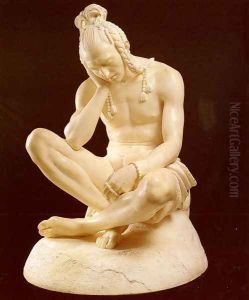Theodore-Charles Gruyere Paintings
Theodore-Charles Gruyère was a French sculptor born on August 16, 1830, in Paris. He is not to be confused with the famous cheesemaking Gruyère family, although his surname often triggers the association. Gruyère showed an early interest in the arts and particularly in sculpture, which was a popular medium among French artists during the 19th century.
Gruyère was trained at the École des Beaux-Arts in Paris, the premier art school in France, which was known for its rigorous classical training and emphasis on historical and mythological subjects. Under the tutelage of prominent sculptors such as François Rude and James Pradier, Gruyère honed his skills and developed a style that blended classical tradition with the emerging currents of naturalism and realism that were beginning to influence French art at that time.
Although he is not as widely recognized today as some of his contemporaries, Gruyère's work was appreciated in his time for its craftsmanship and attention to detail. He exhibited at the Paris Salon, the official art exhibition of the Académie des Beaux-Arts in Paris, where he received favorable reviews for his works. Gruyère's sculptures often depicted allegorical or mythological figures, a common theme among 19th-century French sculptors, as well as historical personages and events.
One of his notable works includes a monument dedicated to Jean-Baptiste Colbert, the French minister of finance under King Louis XIV, which was erected in Reims. He also produced a series of notable funerary monuments, which were highly regarded for their expressive and evocative figures. These works exemplify the 19th-century French tradition of integrating sculpture into architectural and memorial projects.
Theodore-Charles Gruyère's career was part of a broader movement in French sculpture that sought to balance the neoclassical inheritance with the more modern approaches of the late 19th century. His work reflects a period of transition in French art, where academic traditions were increasingly infused with a sense of life and motion, anticipating the developments of the fin-de-siècle.
Gruyère's life and career were cut short when he died on December 2, 1885, in Paris. Although he did not gain the same level of fame as some of his peers, his contributions to French sculpture are nonetheless a testament to the rich artistic environment of his time. Today, his works can be found in various French museums and public spaces, where they continue to be studied and appreciated by art historians and the public alike.
